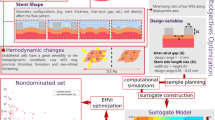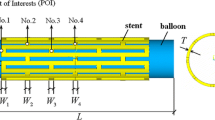Abstract
Coronary artery disease is the leading cause of death among the men and women. One of the most suitable treatments for this problem is balloon angioplasty with stenting. Functionally graded material (FGM) stents have shown suitable mechanical behavior in simulations. While their deformation was superior to uniform materials, the study was aimed at finding the most suitable configuration to reach the optimum performance. A combination of finite element method (FEM) and optimization algorithm have been used to fulfil this objective. To do that, three different conditions have been investigated in a Palmaz-Schatz geometry, where in the first and second ones the stent was a combination of steel and CoCr alloy (L605), and the third condition was a combination of CoCr alloy (L605) and CoCr alloy (F562). In the first and third conditions, dogboning was the objective function, but in the second condition a non-uniform deformation indicator was chosen as the objective function. In all three conditions the heterogeneous index was the control variable. The stent in the third condition showed a poor performance. While in the steel/CoCr alloy (L605) stents the heterogeneous index of 0.374 showed the lowest maximum dogboning, the heterogeneous index of 5 had more uniform deformation. Overall due to the lower dogboning of the steel/CoCr alloy (L605) stent with heterogeneous index of 0.374, this stent is recommended as the optimum stent in this geometrical configuration.
Graphical abstract










Similar content being viewed by others
References
Karimi A, Navidbakhsh M, Shojaei A, Faghihi S. Measurement of the uniaxial mechanical properties of healthy and atherosclerotic human coronary arteries. Mater Sci Eng C. 2013;33:2550–4.
Karimi A, Navidbakhsh M, Shojaei A. A combination of histological analyses and uniaxial tensile tests to determine the material coefficients of the healthy and atherosclerotic human coronary arteries. Tissue Cell. 2015;47:152–8.
Karimi A, Shojaei A, Razaghi R. Viscoelastic mechanical measurement of the healthy and atherosclerotic human coronary arteries using DIC technique. Artery Res. 2017;18:14–21.
Karimi A, Navidbakhsh M, Rahmati SM, Sera T, Kudo S. A combination of constitutive damage model and artificial neural networks to characterize the mechanical properties of the healthy and atherosclerotic human coronary arteries. Artif Organs. 2017 Feb 2. 10.1111/aor.12855.
Karimi A, Navidbakhsh M, Rahmati SM, Sera T, Kudo S, A combination of experimental and numerical methods to investigate the role of strain rate on the mechanical properties and collagen fiber orientations of the healthy and atherosclerotic human coronary arteries. Bioengineered. 2017;8(2):154–70
Li H, Wang X. Design optimization of balloon-expandable coronary stent. Struct Multidiscip Optim. 2013;48:837–47.
Lim D, Cho S-K, Park W-P, Kristensson A, Ko J-Y, Al-Hassani S, et al. Suggestion of potential stent design parameters to reduce restenosis risk driven by foreshortening or dogboning due to non-uniform balloon-stent expansion. Ann Biomed Eng. 2008;36:1118–29.
Khosravi A, Bahreinizad H, Bani MS, Karimi A. A numerical study on the application of the functionally graded materials in the stent design. Mater Sci Eng C. 2017;73:182–8.
Karimi A, Navidbakhsh M, Yamada H, Razaghi R. A nonlinear finite element simulation of balloon expandable stent for assessment of plaque vulnerability inside a stenotic artery. Med Biol Eng Comput. 2014;52:589–99.
Bahreinizad H, Oscuii HN. Numerical investigation of role of synovial fluid in a poroelastic model of natural human knee joint during walking. 2015 22nd Iranian Conference on Biomedical Engineering (ICBME): IEEE; 2015. p. 126–31.
Khosravi A, Bani MS, Bahreinizade H, Karimi A. A computational fluid–structure interaction model to predict the biomechanical properties of the artificial functionally graded aorta. Biosci Rep. 2016;36:e00431.
Karimi A, Navidbakhsh M, Razaghi R. A finite element study of balloon expandable stent for plaque and arterial wall vulnerability assessment. J Appl Phys. 2014;116:044701.
Shirazi HA, Ayatollahi M. Biomechanical analysis of functionally graded biomaterial disc in terms of motion and stress distribution in lumbar spine. Int J Eng Sci. 2014;84:62–78.
De Beule M, Mortier P, Carlier SG, Verhegghe B, Van Impe R, Verdonck P. Realistic finite element-based stent design: the impact of balloon folding. J Biomech. 2008;41:383–9.
Iannaccone F, De Beule M, De Bock S, Van der Bom IM, Gounis MJ, Wakhloo AK, et al. A finite element method to predict adverse events in intracranial stenting using microstents: in vitro verification and patient specific case study. Ann Biomed Eng. 2016;44:442–52.
De Beule M, Van Impe R, Verhegghe B, Segers P, Verdonck P. Finite element analysis and stent design: Reduction of dogboning. Technol Health Care. 2006;14:233–41.
Wang W-Q, Liang D-K, Yang D-Z, Qi M. Analysis of the transient expansion behavior and design optimization of coronary stents by finite element method. J Biomech. 2006;39:21–32.
Schiavone A, Zhao L, Abdel-Wahab A. Dynamic simulation of stent deployment–effects of design, material and coating. J Phy: Conference Series: IOP Publishing; 2013. p. 012032.
Miyamoto Y, Kaysser W, Rabin B, Kawasaki A, Ford RG. Functionally graded materials: design, processing and applications: Springer Science & Business Media; 2013.
Bever M, Duwez P. Gradients in composite materials. Mater Sci Eng. 1972;10:1–8.
Shen M, Bever M. Gradients in polymeric materials. J Mater Sci. 1972;7:741–6.
Sadollah A, Bahreininejad A. Optimum functionally gradient materials for dental implant using simulated annealing: INTECH Open Access Publisher; 2012.
Hedia H, El-Midany T, Shabara M, Fouda N. Development of cementless metal-backed acetabular cup prosthesis using functionally graded material. Int J Mech Mater Design. 2005;2:259–67.
Watanabe Y, Iwasa Y, Sato H, Teramoto A, Abe K, Miura-Fujiwara E. Microstructures and mechanical properties of titanium/biodegradable-polymer FGM for bone tissue fabricated by spark plasma sintering method. J Mater Proc Tech. 2011;211:1919–26.
Enab TA. A comparative study of the performance of metallic and FGM tibia tray components in total knee replacement joints. Comput Mater Sci. 2012;53:94–100.
Conn AR, Scheinberg K, Vicente LN. Introduction to derivative-free optimization: Siam; 2009.
Luenberger DG. Introduction to linear and nonlinear programming. MA: Addison-Wesley Reading; 1973.
Li N, Zhang H, Ouyang H. Shape optimization of coronary artery stent based on a parametric model. Finite Elem Anal Des. 2009;45:468–75.
Ciekot A, Lacki P. Optimization of dogboning phenomenon of the coronary artery stent. Scientific Res Inst Math Comput Sci. 2012;11:25–31.
Khosravi A, Bahreinizad H, Salimi Bani M, Karimi A. A numerical study on the application of the functionally graded materials in the stent design. Mater Sci Eng C. 2017;73:182–8.
Chua SD, MacDonald B, Hashmi M. Effects of varying slotted tube (stent) geometry on its expansion behaviour using finite element method. J Mater Proc Tech. 2004;155:1764–71.
Pochrząst M, Walke W, Kaczmarek M. Biomechanical characterization of the balloon-expandable slotted tube stents. J Achiev Mater Manufact Eng. 2009;37:340–7.
Powell MJ. The BOBYQA algorithm for bound constrained optimization without derivatives. Cambridge NA Report NA2009/06, University of Cambridge, Cambridge 2009.
Karimi A, Navidbakhsh M, Rahmani S, Sera T, Kudo S. Experimental verification of the healthy and atherosclerotic coronary arteries incompressibility via digital image correlation. Artery Res. 2016;16:1–7.
Karimi A, Razaghi R, Shojaei A, Navidbakhsh M. An experimental-nonlinear finite element study of a balloon expandable stent inside a realistic stenotic human coronary artery to investigate plaque and arterial wall injury. Biomed Eng/Biomedizinische Technik. 2015;60:593–602.
Karimi A, Navidbakhsh M, Razaghi R. Plaque and arterial vulnerability investigation in a three-layer atherosclerotic human coronary artery using computational fluid-structure interaction method. J Appl Phys. 2014;116:064701.
Park C-H, Chung M-Y, Unnithan AR, Kim CS. Creation of a functional graded nanobiomembrane using a new electrospinning system for drug release control and an in vitro validation of drug release behavior of the coating membrane. Mater Sci Eng C. 2015;50:133–40.
Choy S, Sun C, Leong K, Tan K, Wei J. Functionally graded material by additive manufacturing. Proceedings of the 2nd International Conference on Progress in Additive Manufacturing (Pro-AM 2016). Singapore: Research Publishing. 2016.
Author information
Authors and Affiliations
Corresponding author
Ethics declarations
Conflict of interest
The authors declare that they have no competing interests.
Rights and permissions
About this article
Cite this article
Khosravi, A., Akbari, A., Bahreinizad, H. et al. Optimizing through computational modeling to reduce dogboning of functionally graded coronary stent material. J Mater Sci: Mater Med 28, 142 (2017). https://doi.org/10.1007/s10856-017-5959-7
Received:
Accepted:
Published:
DOI: https://doi.org/10.1007/s10856-017-5959-7




